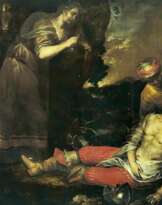Juan Fernández de Navarrete (1526 - 1579)

Juan Fernández de Navarrete
Juan Fernández de Navarrete was a distinguished Spanish Mannerist painter, renowned for his significant contribution to the Renaissance period. Born in 1526 in Logroño, Spain, Navarrete's life was marked by a childhood illness that left him without hearing, earning him the nickname "El Mudo" (The Mute). Despite his challenges, he became a prolific artist, communicating his thoughts and ideas through the powerful medium of painting.
Navarrete's artistic journey began under the tutelage of Fray Vicente de Santo Domingo, a Hieronymite monk in Estella. His talent and skill flourished, leading him to study in major Italian cities like Naples, Rome, Florence, and Milan. During this time, Navarrete was heavily influenced by Venetian art, particularly by the works of Titian, whom he is believed to have studied with.
In 1568, Navarrete's career took a significant turn when he was appointed as the court painter to Philip II of Spain. This role led him to work on the Escorial, a grand monastery-palace still under construction. Here, Navarrete's works were instrumental in bringing Venetian influences to Spanish art. His paintings, characterized by rich, warm coloration and bold designs, were a departure from the traditional Spanish style of the time. Among his most celebrated works at the Escorial are "Nativity," where the light emanates from the infant Saviour, and the "Baptism of Christ," now housed in the Prado Museum.
His art, often depicting religious themes, was marked by a blend of sketchy distances with rich color and realistic foreground effects. Despite the challenges of his disability, Navarrete's works exhibit a remarkable depth of emotion and skill, securing his place as a significant figure in the Spanish Renaissance.
Juan Fernández de Navarrete's legacy continues to inspire and captivate art enthusiasts, collectors, and experts. His works, a blend of Spanish tradition and Venetian influence, represent a unique chapter in the history of art. For those interested in exploring Navarrete's masterpieces, a visit to the Prado Museum in Madrid is a must.
For updates on exhibitions and events featuring Juan Fernández de Navarrete's work, sign up for our newsletter. Stay informed about upcoming sales and auction events specifically related to this master of Spanish Renaissance art in a business-like, straightforward manner.
| Date and place of birt: | 1526, Logroño, Spain |
|---|---|
| Date and place of death: | 28 march 1579, Toledo, Spain |
| Period of activity: | XVI century |
| Specialization: | Artist, Painter |
| Art school / group: | Castilian tenebrism |
| Genre: | Religious genre |
| Art style: | Mannerism, Old Masters |















